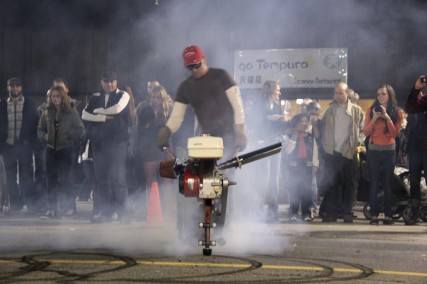I’m just here for the gasoline.
by Ivan Jurakic
Steven Laurie’s flamboyant artworks reiterate the original appeal of Pop art in the 1960s, tapping into the vernacular of muscle cars and street racing as subject matter. Like a latter-day Robert Indiana, Laurie appropriates common elements from hot-rod decals to high gloss finishes to make his ersatz artifacts. Pop art came about during a halcyon period of unbridled wealth and prosperity, in which the economy was sound, well paying manufacturing jobs were secure, fossil fuels seemed limitless, and the promise of a classless society seemed well within sight. By contrast, Laurie’s work follows in the wake of downsizing and the outsourcing of labour in the 1990s and the still lingering repercussions of the more recent recession and housing crisis of 2008. If the post-war period represented a boom time then Laurie’s artworks suggest its antithesis: a palpable bust, the inevitable hangover from a promised utopia.
The automobile was emblematic of this promise. The Big 3 automakers—Ford, GM and Chrysler—represented the pinnacle of the post-war production boom. The factory floors of Detroit marked the zenith of North American economic dominance and by extension the livelihood and prosperity of workers and families from Windsor to St. Catharines. Since the 1980s however, the Rust Belt has inexorably fallen from grace; a once mighty economic engine reduced to a largely hollowed out shell. Regardless, muscle cars and motorcycles endure as tangible objects of mass-produced efficiency and desire, and Laurie’s work taps into the same well of ingenuity and showmanship that led young men to start modifying and customizing their vehicles in the first place.

Donut Machine (2007)—a refinement of Laurie’s earlier Handheld Rubber Burner (2005)—celebrates the sound and fury of illegal street racing. Sporting a fat rubber tire powered by a 10 horsepower engine, the machine is a hand-operated contraption that looks more like a souped-up rototiller than a custom chopper. Despite its absurdity, Laurie has laboured to get the details right; from the stainless steel exhaust to chrome plated chain guards and a single fender painted Chevy engine block orange. Witnessing the artist wearing his signature T-shirt and ball cap wrestling with this device in the parking lot of an art gallery is an integral part of experiencing his work. Gamely revving the engine, the Donut Machine roars loudly while belching clouds of blue-grey smoke as the artist burns a circle of thick black rubber into the pavement. The heroic bravado of the performance is self-consciously undercut by the futility of the gesture and the effort involved in achieving it.
While Laurie’s artworks gamely impersonate the performance and styling of customized motorcraft, they accomplish very little. Like the Wild Thing Handheld Revver (2005), a modified chainsaw sporting a flame-embossed chrome tailpipe, Laurie’s take on customization is closely related to kitbashing, where model enthusiasts mix and match parts from various commercially available model kits to create their own hybrids. 2 While many of the components can be purchased straight off the shelf at Princess Auto, the artist consciously recombines them so that form trumps function. Each contraption gleefully evokes our fascination with the unheralded innovations of amateur gearheads labouring away in basements and garages fabricating makeshift prototypes.
With the Mud Flap Project (2008-) Laurie takes his work on the road in a different way. The artist designed 55 pairs of custom rubber mud flaps proudly displaying his full name above polished stainless steel silhouettes featuring various emblems related to his art practice. At once satirical and self-aggrandizing this project is also a rather ingenious method of community outreach:
A friend of mine and I were sitting on the sidewalk one day, and wondering out loud what it would take for people who didn’t typically talk about art to be compelled to come into a gallery or be interested in a contemporary art show. 3
To accomplish this goal, Laurie made his mud flaps available for free to any legitimate driver or company with a truck or tractor-trailer that requested them, including the professional art movers PACART. His custom mud flaps are still travelling across North America and have likely been witnessed by thousands of motorists along highways and at truck stops located far from the nearest gallery. In this way, Laurie’s work succeeds in connecting with a broad range of viewers ranging from visual artists to car customizers, heavy metal fans to truckers.
Having been raised in the suburbs of Oshawa, Ontario—a city with first-hand experience of the boom-and-bust cycle of automotive manufacturing—Laurie’s work is not just a pastiche of blue-collar values. It can be read as both a heartfelt tribute to his working class upbringing and as a pointed rebuke to the current epidemic of affluenza that has gripped North America. While we live in a technologically advanced society flush with innovative gadgets and unbeatable low prices, all indications suggest that this way of life is unsustainable, that we may be poised on the brink of economic and environmental collapse. Laurie’s projects may evoke affection but they also infer the troubling paradox that the internal combustion engine has come to represent.
___________________________________________________________________________________________________________________________
1 Mad Max Rockatansky, Mad Max 2: The Road Warrior, Warner Bros., 1981. http://www.imdb.com/title/tt0082694/
2 Canadian artist Kim Adams is a well-known aficionado of this method of artmaking.
3 Artist Profile: Steven Laurie, posted by Carolyn Tripp, June 26, 2009. http://mondomagazine.net/2009/artist-profile-steven-laurie/
[Essay contribution to Jacked! catalogue]
